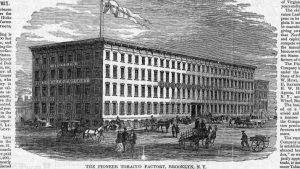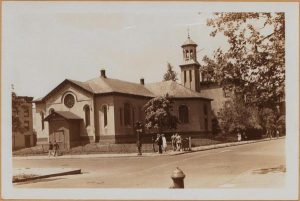Fun Facts about Cobble Hill history!
By Lesley Alderman
1. Rents were cheaper in 1879
But you knew that. If you were lucky enough to score an apartment in Cobble Hill Towers, the Alfred Tredway White building that was designed as worker housing, your tab would have been $7.20 to $14 a month in 1879, just $168 to $325 in today’s dollars.
2. The Towers had storefronts
Speaking of the Towers, before the BQE was installed in the 1950s, Hicks was a lively commercial street on which storefronts with awnings were common (see picture below, left). Once the BQE sliced through Hicks Street, the sidewalks became inhospitable to shoppers and the storefronts shut down.

Photo: Brooklyn Historical Society
3. Chewing tobacco was made
The Pioneer Tobacco Factory, which was located on the west side of Hicks Street, between Warren and Baltic, manufactured and packaged chewing tobacco in the 1860s and 70s. According to Brownstoner, “Pioneer’s tobacco used a finer quality of leaf, flavored with sugar and licorice, and it sold extremely well. This large factory produced $2.5 million worth of chewing tobacco in 1872, and employed 450 people.”

Credit: Published in “Harper’s Weekly” January 1870
4. Streets were not so leafy
Just fifty or so years ago, Cobble Hill was nearly treeless. Thanks to the insistent efforts of local resident George Polimeros, Cobble Hill now boasts hundreds of trees, including London Planes, Red Oaks, and Norway Maples. Polimeros, an engineer and tree lover who died in 1979, started his tree campaign single handedly back in the 1960s. The story goes Polimeros would go door to door asking his neighbors to contribute to the tree fund. “He planted more than 2,000 trees,” his widow, Demetra Polimeros, told the New York Times in 2008. The Cobble Hill Tree Fund was created to carry on his good work.

Henry Street, before trees were planted. Photo: P. L. Sperr, 1940
5. Zebras slept on Pacific
When the Ringling Brothers and Barnum & Bailey Circus was in town, the Zebras would bunk at 173 Pacific Street. The former stable (now a luxurious carriage house), boarded the animals between 1915 and 1920. ”The animals were brought in by train. They arrived at the Flatbush Terminal and walked up Atlantic Avenue. The building next door held the elephants,” former owner, Richard Turmail, told the New York Times.
6. A Rifle Range was founded (and still thrives)
Founded in the 1930s, the Metropolitan Rod and Gun Club on Pacific Street has indoor pistol, rifle and archery ranges. During World War II the Club helped to qualify the entire Brooklyn division of the City Patrol Corps of over 5,000 men, on its range.
7. Cobblestones were common
Tiffany Place is the only cobble-stoned street in the neighborhood, but in the 1800s cobble-stoned streets were ubiquitous. The stones were made from ships’ ballasts and paved many of the local roads.
8. George Washington commanded troops
The spot where Trader Joe’s is situated was once a steep conical hill— referred to as Cobbleshill on a survey of Brooklyn dating from 1767. During the Battle of Brooklyn, the steep spot became Cobble Hill Fort, a key look out point from which General Washington viewed the fighting at the Gowanus Creek.
9. There was a Church of the Holy Turtle
The church part is real, the turtle part made up. The Second Unitarian Church was built in 1858 on the site of what is now Cobble Hill Park. This church became a cultural and abolitionist center and one of its parishioners, Mary White Ovington, was a founder of the National Association for the Advancement of Colored People (NAACP). The structure had an odd humpbacked shape, which local residents believed resembled a turtle—hence the name. The church was abandoned in the 1950s and torn down in 1962.

Photo: P. L. Sperr. c. 1934
10. Thomas Wolfe wrote
The famed writer lived in a cramped basement apartment at 40 Verandah Place in the 1930s. Wolfe appreciated the neighborhood, but not his apartment. He wrote of his abode in his story, No Door:
The place you live in is shaped just like a Pullman car, except it is not so long and has only one window at each end. There are bars over the front window that your landlady has put there to keep the thugs in that sweet neighborhood from breaking in; in the winter the place is cold and dark, and sweats with clammy water; in the summer you do all the sweating yourself, but you do plenty of it, quite enough for anyone; the place gets hot as hell.
11. Aaron Copland was Bar Mitzvah’ed
In 1913 Copland celebrated his coming of age at the Kane Street Synagogue (see below), where his dad, Harris Copland, served as president of the congregation. Copland and his family lived about a 20-minute ride away on Washington and Dean Street, above the family store, H.M. Copland’s Department Store. According to The Brooklyn Eagle, “the store dealt mainly in dry goods, shoes, toys and household items. Corsets and ribbons were big sellers. From 1906 on, the store had a telephone. Aaron remembered the number as Prospect 4666.”
12. A synagogue was once a church
Congregation Baith Israel Anshei Emes, aka the Kane Street Synagogue (which until 1928 was known as Harrison Street Synagogue), moved to its present location in 1905. The congregation paid $30,000 for the building, which had been erected as the Middle Reformed Protestant Dutch Church in 1855. Interim owners of the Romanesque revival building were the Salvation Army and the Trinity German Lutheran Church.

Photo: NYPL Digital Collection, c. 1940
13. An elevator set a record
The Degraw Mansion at 219 Clinton Street on the corner of Amity—one of the most prominent homes in Cobble Hill—was built in 1844 for Abraham J. S. Degraw, a wealthy commission merchant*. The house was enlarged and redesigned in 1890 by the next owners, Laura and Ralph Cutter. The new owners added a tower to ensure a view of the harbor, which had become blocked by the development of the neighborhood. Rumor has it the Mansion was home to one of the first private elevators in Brooklyn!
(*Commission merchants were a significant part of commercial life in the 1800s. They advanced money to planters and manufacturers and in return, the products of farm and factory were consigned to them for sale.)

14. Convents were common
Where there are churches, there are bound to be convents. Homes for nuns were located on the NE corner of Congress and Clinton (below left) and on Baltic between Henry and Hicks. Another was on Kane and Henry, opposite PS 29, and called the Nursing Sisters of the Sick Poor/Congregation of the Infant Jesus. According to Lost City, “The Nursing Sisters …. was an order which began in France. They devoted their time to caring for the sick, looking after their homes and giving them medicine. The nuns used to hold dances to raise money….the buildings were built in the 1850s and are among the oldest in the area. The nuns moved in in 1906 and it became a convent.”

15. A tunnel also set a record
The Atlantic Avenue Tunnel, a ½ mile tunnel that runs under Atlantic Avenue from Columbia Street to Boerum Place, was built in 1844 by the LIRR. The Tunnel, which ra had a short life span; in 1861 New York State banned railroad locomotives from within the City of Brooklyn and after just 17 years the Tunnel was sealed shut. Bob Diamond discovered the Tunnel in 1980 and for 30 years led tours through the subterranean novelty. In 2011, the Tunnel was granted the Guinness world record for “oldest subway tunnel,” (even though it is actually a railway tunnel).
